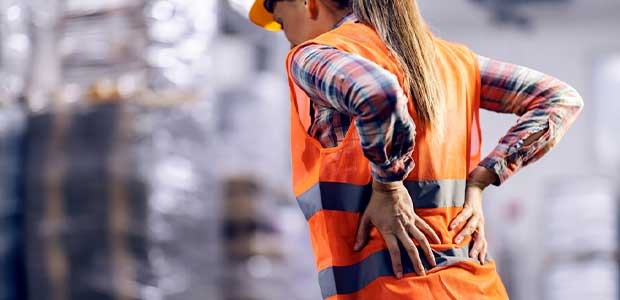
Here’s Why Constant Bending Can Be Troublesome
No, back pain is not caused just by heavy lifting.
- By Matthew Marino
- Oct 03, 2022
A healthy back is invaluable for a logistics worker—for most, their livelihood literally depends on it. Unfortunately, movements essential to their fast-paced workday—such as overexertion from repeatedly bending over to pick up and put down boxes—can create cumulative damage that increases the risk of a work-related musculoskeletal disorder (WMSD).
And there’s good reason to take WMSDs seriously: OSHA said WMSDs are among the most frequently reported causes of lost or restricted work time, and the annual cost for treatment and lost wages from back pain domestically is $253 billion, according to the Bone and Joint Initiative.
Amazon has increased its attention and directed financial resources to combat WMSDs with its WorkingWell program, which is a step in the right direction. The juggernaut company had reason to emphasize warehouse safety—Amazon recorded 5.6 injuries per 100 workers in 2019, while the national average for the warehousing and storage sector was 4.8.
Because even the 4.8 average is still too high, it's important to understand why logistics/warehouse workers are at-risk of suffering back-related WMSDs that could turn into chronic pain. Back pain is associated with heavy lifting—somebody grimacing and feeling the pain in the lower back ramp up after trying to haul something too heavy.
However, repetitively loading the back and the awkward postures that come with moderate lifting as well as frequent and static bending can add up to be a very painful (and expensive) problem.
Let’s take a look at why movements like bending are so bad for your back.
The Science Behind Back Pain
The back functions like a see-saw: The spine works as the fulcrum with your body weight and anything you’re holding on one side, and your lower back muscles pulling on the other. Even standing upright, muscles in your back pull downward to keep the front of your body upright.
When you bend forward even just a few inches, muscles along your back and legs engage and pull on your upper body with about 100 pounds of force to keep you balanced. And that’s only bending forward a few inches and holding no extra weight.
Bending all the way down to put a 25-pound box on the floor or pick up a bag of dog food can require back muscles to pull with 300-500 pounds of force on your lower back. With all those repetitions and forces, the spine and its muscles and surrounding tissues can easily become fatigued, and that’s when the risk of injury jumps way up.
Considering how much bending and lifting logistics workers do every day, it’s no wonder WMSDs can be such a serious issue.
Back Pain Is a Symptom of the Real Problem
Remember, back pain is a symptom of the problem. The real problem is the strain, fatigue and wear and tear from the frequent forces and awkward postures that logistics workers’ spines must endure every day.
So no, back pain is not caused just by heavy lifting. There definitely are back injuries from heavy lifting (and precautions should be in place that prevent anyone from even attempting such a lift), but constant punishment from bending and moderate lifting exposes workers to risk for an injury that could not only prevent them from working today, but also risk plaguing them with a lifetime of chronic back issues.
It’s important that companies are putting a greater emphasis on injury prevention—Amazon said it’s investing $300 million in safety projects this year and that the company has seen a 32 percent drop in WMSDs in 2020 compared to the previous year. According to a Wall Street Journal article, some aspects of Amazon’s “WorkingWell” program include:
- Watching videos about injury prevention and proper lifting technique.
- Hourly prompts that guide workers through stretching and breathing exercises.
- Staffing schedules that rotate employees among jobs that use different muscle groups to reduce repetitive-stress injuries.
These strategies are certainly helpful in the fight against WMSDs, however, there are new tools available for companies that want to lower the risk of back injuries before they happen.
New Tools Like Exosuits Can Help Protect Workers
Companies big and small are using exosuit technology to protect their workers. Some exosuits on the market are practical for logistics companies because they are comfortable and provide much-needed back assistance without compromising freedom-of-movement.
To be a realistic option for logistics workers, exosuits can’t get in the way. That’s something to really keep in mind, especially for logistics workers who are constantly on the move but need that bask assistance: Freedom-of-movement and comfort are critical for occupational wearables.
That’s why many exosuits are designed to be lightweight and ergonomic, with the question of practicality in mind: Can a worker wear this and still perform their job?
If you’d like to learn more about exosuits, sites like ExoskeletonReport.com offer balanced and relevant information.
America has a back pain crisis and heavy lifting isn’t the only reason behind it. The repetitive, physical movements logistics workers need to make every day put a target on their backs and increase their risk of suffering chronic back pain.
On the bright side, modern tools like exosuits are here to help companies looking to fight this billion-dollar back pain problem and equip a healthier, safer workforce.
This article originally appeared in the October 1, 2022 issue of Occupational Health & Safety.